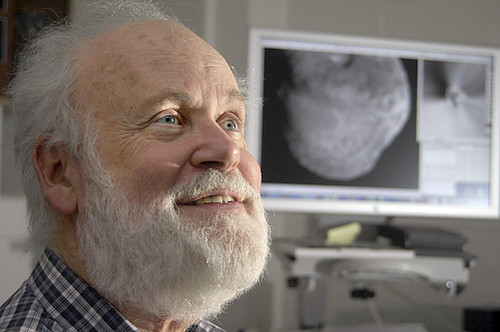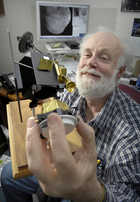EPOXI
Two intriguing investigations -- One flight-proven spacecraft
News: Second life for comet chaser, 2008.02.16
In the News
Second life for comet chaser: Spacecraft to look for Earth-like planets2008.02.16
By Dennis O'Brien | Sun reporter
February 16, 2008

Michael A'Hearn is the principal investigator for the EPOXI mission, which will look at another comet while hunting planets. (Sun photo by Amy Davis / February 8, 2008)
Michael A'Hearn is about to find out if there are second acts in American astronomy.
The University of Maryland scientist made international news in 2005 when he ran the Deep Impact mission, which slammed an 820-pound projectile into the path of a comet speeding through space at 23,000 mph.
The smash-up became one of the most widely watched unmanned projects in NASA history.
A'Hearn is now overseeing a $41 million NASA mission that recycles the Deep Impact spacecraft - which fired the projectile into the comet - to search for Earth-like planets in our interstellar neighborhood. The two-year project, now yielding its first data, will also produce one of the closest looks yet at another comet and unprecedented images of Earth from space.
"We're trying to build on what we've learned so far," said A'Hearn.
After it made history by blowing a big hole in comet Tempel 1, scientists recalibrated Deep Impact's instruments to help it use Earth's gravity to propel it along on a new, 1.6 billion-mile journey. The spacecraft will spend five months searching for Earth-like planets, survey some Jupiter-sized ones and then fly toward the comet Hartley 2 for a close-up look.
Reconfiguring an existing probe made the mission an easier sell because it's a relative bargain. "You save the cost of designing, constructing and launching a whole new craft," A'Hearn said.
NASA approved the two-year mission, known as EPOXI, in December. The name is an acronym combining the project's initial, six-month leg, the Extrasolar Planet Observation and Characterization, with its follow-up comet rendezvous, the Deep Impact Extended Investigation.
There will be no comet smashup this time. Because of the path of Hartley 2, the spacecraft must approach from the comet's dark side - away from the Earth - which would make it impossible to beam back images of a collision. "We thought about it having the spacecraft crash right into it, and taking imagery of that, but there was no way," A'Hearn said.
But the EPOXI spacecraft will come within 620 miles of the half-mile wide comet in a rendezvous scheduled for Oct. 11, 2010.
Astronomers designed the mission to resolve questions raised by Deep Impact and its collision with comet Tempel 1 on July 4, 2005. What they saw then surprised them: impact craters, smooth glacier-like channels along the comet's surface and twice-a-week outbursts of granular material.
"We're asking, do all comets have this, do they do all these things, or is this a weirdness we should ignore?" A'Hearn said.
A'Hearn has been studying the origin, composition, and behavior of comets since he arrived at Maryland to teach astronomy in 1966.
"I got into them because nobody else was studying comets at the time, and I thought, here was an area where I could make a contribution," he said.
At 67, A'Hearn has no intention of retiring when the EPOXI mission is completed in 2010. He's on a team designing instruments that will help NASA and the European Space Agency land a probe on another comet in 2014.
He selected the comet Hartley 2 for the EPOXI mission because it's one of the few comets that will pass near enough for a detailed look in the next two years. "If you're going to study a comet, the first thing you have to make sure of is that you're close enough," he said.
Most of what astronomers know about comets is based on images from ground-based telescopes, A'Hearn said. But they're worth studying because they hold clues to mysteries of the solar system's formation 4.5 billion years ago, A'Hearn said.
As interstellar dust and other material drew together to form Earth and our neighboring planets, the process generated heat and changed each planet's chemistry, A'Hearn said. But that heat was never generated on the smaller, icy bodies we call comets and so their internal chemistry is still intact, he said.
"With a comet, you find preserved the molecular composition of everything that existed back then that could make anything solid," he said.
A'Hearn and researchers at the NASA Goddard Space Flight Center began the first part of the mission last week studying the first images in EPOXI's search for Earth-like planets.
As part of that search, EPOXI's telescope will spend the next five months collecting imagery and data from five stars orbited by planets much larger than the Earth, said Drake Deming, an astronomer at NASA Goddard Space Flight Center and deputy principal investigator on EPOXI.
Between star scans, the spacecraft will turn and take high- and medium resolution images of the Earth.
EPOXI's best hope for finding a habitable, Earth-sized planet lies in its scan of the heavens around Gliese 436, a star 33 light years away. Unlike the others, it is known to have an orbiting, Neptune-sized planet with hydrogen and helium in its atmosphere, Deming said. That means it might also have a smaller, Earth-sized body orbiting nearby.
But don't hold your breath.
"It's conceivable we could find a habitable Earth-like planet," Deming said. "But it is kind of a long shot."
Copyright © 2008, The Baltimore Sun
Dennis O'Brien
Baltimore Sun
dennis.obrien [at] baltsun [dot] com
Source

